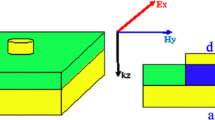Abstract
The field of plasmonics has experienced a renaissance in recent years by providing a large variety of new physical effects and applications. Here, we demonstrate a light humidity sensor of surface plasmon resonance (SPR) by a symmetric metal film, which uses P polarised light of emergent He–Ne laser to stimulate SPR. Resonance angle change received by the spectrum detector can determine humidity via the relationship between humidity and effective refractive index. When the relatively short wavelengths are shown in the model, the evanescent wave penetration depth is shallow, resonance state is weak and energy loss is low. The opposite results are obtained, when the wavelength is long. Also, with increasing thickness, the resonance peak becomes acute, thereby indicating the improvement in detection accuracy. When the metal thickness of our model is 50 nm, the resonance peak of the reflection spectrum is narrower, accuracy is high and reflectivity is close to 0. By analysing the experimental results, the SPR resonance phenomenon is shown. The electromagnetic field energy is highly concentrated near the interface between the metal and SiO2, which appears highly localized. The resolution of the structure can reach 0.37% RH (relative humidity), which is significantly more than the resolution of capacitive humidity sensor, i.e., resolution is usually 1% RH to 2% RH. The optical sensor of our development can provide a key device for long-distance transmission sensing, in special conditions such as low temperature.










Similar content being viewed by others
References
Zhou F et al (2017) Extending the frequency range of surface plasmon polariton mode with meta-material. Nano-Micro Letters 9(1)
Burov DA, Evstigneev NM, Magnitskii NA (2017) On the chaotic dynamics in two coupled partial differential equations for evolution of surface plasmon polaritons. Communications in Nonlinear Science & Numerical Simulation 46:26–36
Li H et al (2017) Converting surface plasmon polaritons into spatial bending beams through graded dielectric rectangles over metal film. Opt Commun 383:423–429
Ortuño R et al (2015) Role of surface plasmon polaritons on optical transmission through double layer metallic hole arrays. Pediatr Pol 58(2):149–152
Derrien TJ et al (2014) Rippled area formed by surface plasmon polaritons upon femtosecond laser double-pulse irradiation of silicon. Applied Physics A 21(1):29643–29655
Wang JC, Wang XS, Chen BS, et al (2014a) The transmission characteristics of surface plasmon polaritons in waveguide and ring micro-cavity structure[J]. Journal of Natural Science of Heilongjiang University 5:20
Zhang HC et al (2015) Broadband amplification of spoof surface plasmon polaritons at microwave frequencies. Laser Photonics Rev 9(1):83–90
Kawasaki T, Watanabe T, Fukushima T, et al (2013) Gain enhancement effect of surface plasmon polaritons on terahertz stimulated emission in optically pumped monolayer graphene[J]. New J Phys 15(7):075003
Jia YY et al (2015) Broadband frequency-selective spoof surface plasmon polaritons on ultrathin metallic structure. Scientific Reports 5:8165
Wang W et al (2014b) Interplay between strong coupling and radiative damping of excitons and surface plasmon polaritons in hybrid nanostructures. ACS Nano 8(1):1056–1064
Jin TK, Park S (2014) Corrigendum: vertical polarization beam splitter using a hybrid long-range surface plasmon polariton waveguide (2014 J. Opt. 16 025501). J Opt 16(2)
Lopezgarcia M et al (2014) Efficient out-coupling and beaming of Tamm optical states via surface plasmon polariton excitation. Appl Phys Lett 104(23):231116–231116-5
De Leon I et al (2014) Measurement of the complex nonlinear optical response of a surface plasmon-polariton. Opt Lett 39(8):2274–2277
Zhang Z et al (2016) Propagating surface plasmon polaritons: towards applications for remote-excitation surface catalytic reactions. Advanced Science 3(1)
Lu H et al (2014) Graphene-based active slow surface plasmon polaritons. Sci Rep 5
Gao X, Zhou L, Cui TJ (2015) Odd-mode surface plasmon polaritons supported by complementary plasmonic metamaterial. Sci Rep 5
Bi YG et al (2014) Surface plasmon-polariton mediated red emission from organic light-emitting devices based on metallic electrodes integrated with dual-periodic corrugation. Scientific Reports 4:7108–7108
Chen J et al (2014) Ultra-broadband unidirectional launching of surface plasmon polaritons by a double-slit structure beyond the diffraction limit. Nanoscale 6(22):13487–13493
Janipour M, Pakizeh T, Hodjat-Kashani F (2014) Optical interaction of a pair of nanoholes in Au film via surface plasmon polaritons. IEEE Photonics Journal 6(3):1
Bernardi M et al (2015) Theory and computation of hot carriers generated by surface plasmon polaritons in noble metals. Nat Commun 6
Bai Y, Jiang Y, Liu L (2014) Role of surface plasmon polaritons on the enhancement of the near-field thermal radiation from fishnet metamaterial. Journal of Physics D Applied Physics 47(44):507–513
Muller JPB, Leosson K, Capasso F (2014) Polarization-selective coupling to long-range surface plasmon-polariton waveguides. Nano Lett 14(10):5524–5527
Mueller JPB, Leosson K, Capasso F (2014) Polarization-selective coupling to long-range surface plasmon polariton waveguides. Lasers and Electro-Optics IEEE 5524–5527
Acknowledgements
This work was supported by the Guangxi Natural Science Foundation (2015GXNSFBA139257), Guangxi Key Laboratory of Automatic Detecting Technology and Instruments (YQ16206), and Guangxi Normal University Key Program (2015ZD03).
Author information
Authors and Affiliations
Corresponding author
Rights and permissions
About this article
Cite this article
Zhu, J., Xu, Z., Xu, W. et al. Light Humidity Sensor of Surface Plasmon Resonance by Symmetric Metal Film. Plasmonics 13, 681–686 (2018). https://doi.org/10.1007/s11468-017-0560-y
Received:
Accepted:
Published:
Issue Date:
DOI: https://doi.org/10.1007/s11468-017-0560-y




